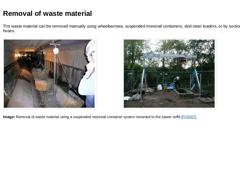
|
The waste material can be removed manually using wheelbarrows, suspended monorail containers, skid steer loaders, or by suction hoses. (Image: Suspended track and containers system) (Image: Removal of the waste container using a gantry crane) Image: Removal of waste material using a suspended monorail container system mounted to the sewer soffit [FI-IDST]. |
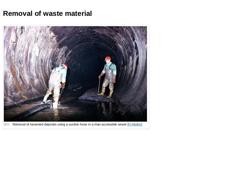
|
(Image: Removal of loosened deposits using a suction hose in a man-accessible sewer) |
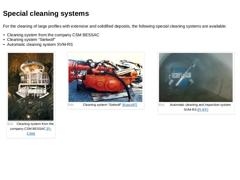
|
For the cleaning of large profiles with extensive and solidified deposits, the following special cleaning systems are available: -
Cleaning system from the company CSM BESSAC
-
Cleaning system “Sielwolf”
-
Automatic cleaning system SVM-RS
|
(Image: Cleaning system from the company CSM BESSAC) |
(Image: Cleaning system “Sielwolf”) |
(Image: Automatic cleaning and inspection system SVM-RS) |
|
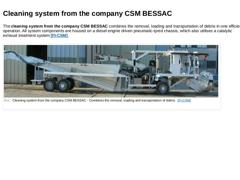
|
The cleaning system from the company CSM BESSAC combines the removal, loading and transportation of debris in one efficient operation. All system components are housed on a diesel engine driven pneumatic-tyred chassis, which also utilises a catalytic exhaust treatment system [FI-CSM]. (Image: Cleaning system from the company CSM BESSAC) |
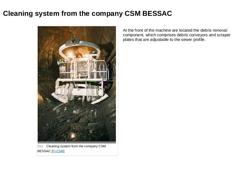
|
(Image: Cleaning system from the company CSM BESSAC) At the front of the machine are located the debris removal component, which comprises debris conveyors and scraper plates that are adjustable to the sewer profile. |
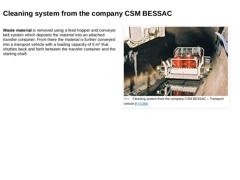
|
Waste material is removed using a feed hopper and conveyor belt system which deposits the material into an attached transfer container. From there the material is further conveyed into a transport vehicle with a loading capacity of 5 m³ that shuttles back and forth between the transfer container and the starting shaft. (Image: Cleaning system from the company CSM BESSAC – Transport vehicle) |
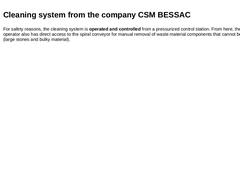
|
For safety reasons, the cleaning system is operated and controlled from a pressurized control station. From here, the machine operator also has direct access to the spiral conveyor for manual removal of waste material components that cannot be transported (large stones and bulky material). |
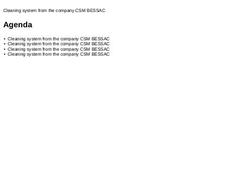
|
|
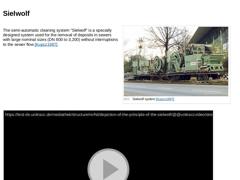
|
The semi-automatic cleaning system “Sielwolf” is a specially designed system used for the removal of deposits in sewers with large nominal sizes (DN 800 to 3,200) without interruptions to the sewer flow [Kupcz1987]. (Video: Depiction of the principle of the "Sielwolf") Video: Operational process of the "Sielwolf" [Image: visaplan GmbH]. This interactive object is only visible online. |
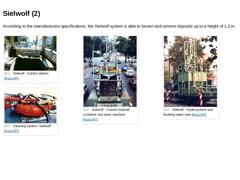
|
According to the manufacturers specifications, the Sielwolf system is able to loosen and remove deposits up to a height of 1.2 m. |
(Image: Sielwolf - Control station) |
(Image: Sielwolf - Coarse material container and sieve machine) |
(Image: Sielwolf - Hydrocyclone and flushing water tank) |
|
(Image: Cleaning system “Sielwolf”) |
|

|
|
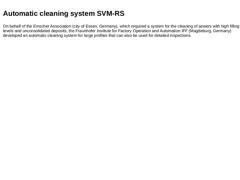
|
On behalf of the Emscher Association (city of Essen, Germany), which required a system for the cleaning of sewers with high filling levels and unconsolidated deposits, the Fraunhofer Institute for Factory Operation and Automation IFF (Magdeburg, Germany) developed an automatic cleaning system for large profiles that can also be used for detailed inspections. |
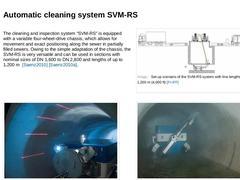
|
The cleaning and inspection system “SVM-RS” is equipped with a variable four-wheel-drive chassis, which allows for movement and exact positioning along the sewer in partially filled sewers. Owing to the simple adaptation of the chassis, the SVM-RS is very versatile and can be used in sections with nominal sizes of DN 1,600 to DN 2,800 and lengths of up to 1,200 m [Saenz2010] [Saenz2010a]. (Image: Set up scenario of the SVM-RS system with line lengths … |

|
Congratulations! You have successfully finished this module. Next you will have the opportunity to review the newly acquired knowledge with an interactive questionnaire. You can of course still navigate back to any point in the moduls if you wish to review a specific point or subject. Stay curious! |
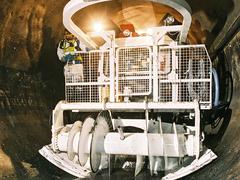
|
The cleaning of large profile sewers poses special challenges to skilled workers. This module deals exclusively with the cleaning of large profile sewers. Among other things, the module focuses on the presentation of machines that have been specially designed for this purpose. After completing this module, you will have knowledge regarding: - procedures for cleaning large profiles;
- general conditions for large profile cleaning.
|
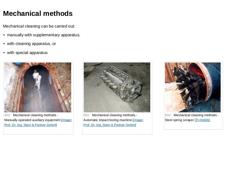
|
Mechanical cleaning can be carried out: -
manually with supplementary apparatus,
-
with cleaning apparatus, or
-
with special apparatus
|
(Image: Mechanical cleaning methods - Manually operated auxiliary equipment) |
(Image: Mechanical cleaning methods - Automatic impact boring machine) |
(Image: Mechanical cleaning methods - Steel spring scraper) |
|
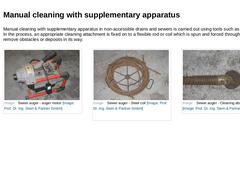
|
Manual cleaning with supplementary apparatus in non-accessible drains and sewers is carried out using tools such as rods or coils. In the process, an appropriate cleaning attachment is fixed on to a flexible rod or coil which is spun and forced through the line to remove obstacles or deposits in its way. (Image: Sewer auger - auger motor) (Image: Sewer auger - Steel coil) (Image: Sewer auger - Cleaning attachment) |
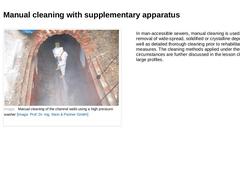
|
(Image: Manual cleaning of the channel walls using a high pressure washer) In man-accessible sewers, manual cleaning is used for the removal of wide-spread, solidified or crystalline deposits, as well as detailed thorough cleaning prior to rehabilitation measures. The cleaning methods applied under these circumstances are further discussed in the lesson cleaning of large profiles. |
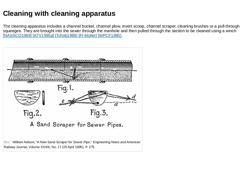
|
The cleaning apparatus includes a channel bucket, channel plow, invert scoop, channel scraper, cleaning brushes or a pull-through squeegee. They are brought into the sewer through the manhole and then pulled through the section to be cleaned using a winch [NASSCO1989] [ATV1995a] [Tchob1989] [FI-Müller] [WPCF1985]. (Image: Sand Scraper for Sewer Pipe) |
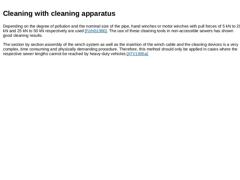
|
Depending on the degree of pollution and the nominal size of the pipe, hand winches or motor winches with pull forces of 5 kN to 20 kN and 25 kN to 50 kN respectively are used [Führb1980]. The use of these cleaning tools in non-accessible sewers has shown good cleaning results. The section by section assembly of the winch system as well as the insertion of the winch cable and the cleaning devices is a very complex, time consuming and physically demanding … |
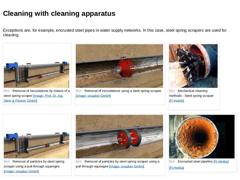
|
|
Exceptions are, for example, encrusted steel pipes in water supply networks. In this case, steel spring scrapers are used for cleaning. |
|
(Image: Removal of incrustations by means of a steel spring scraper) |
(Image: Removal of incrustations using a steel spring scraper) |
(Image: Mechanical cleaning methods - Steel spring scraper) |
|
(Image: Removal of particles by steel spring scraper using a pull-through squeegee) |
(Image: Removal of particles by … |
|
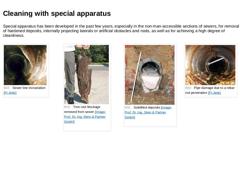
|
Special apparatus has been developed in the past few years, especially in the non-man-accessible sections of sewers, for removal of hardened deposits, internally projecting laterals or artificial obstacles and roots, as well as for achieving a high degree of cleanliness. (Image: Sewer line incrustration) (Image: Tree root blockage removed from sewer) (Image: Solidified deposits) (Image: Pipe damage due to a rebar rod penetration) |
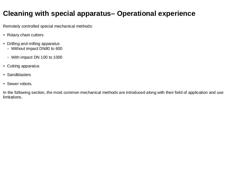
|
Remotely controlled special mechanical methods: -
Rotary chain cutters
-
Drilling and milling apparatus
-
Cutting apparatus
-
Sandblasters
-
Sewer robots.
In the following section, the most common mechanical methods are introduced along with their field of application and use limitations. |
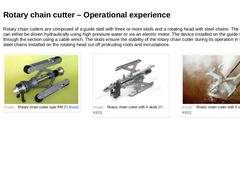
|
Rotary chain cutters are composed of a guide sled with three or more skids and a rotating head with steel chains. The rotating head can either be driven hydraulically using high pressure water or via an electric motor. The device installed on the guide sled is pulled through the section using a cable winch. The skids ensure the stability of the rotary chain cutter during its operation in the sewer. The steel chains installed on the rotating head … |
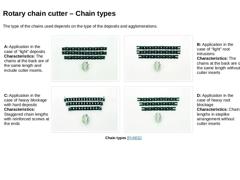
|
The type of the chains used depends on the type of the deposits and agglomerations. |
A: Application in the case of “light” deposits Characteristics: The chains at the back are of the same length and include cutter inserts. |
(Image: Rotary chain for “light” deposits) |
(Image: Rotary chain for removing “light” root intrusions) |
B: Application in the case of “light” root intrusions Characteristics: The chains at the back are of the same length without … |
|